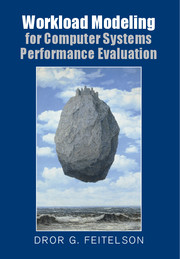Book contents
- Frontmatter
- Dedication
- Contents
- PREFACE
- 1 Introduction
- 2 Workload Data
- 3 Statistical Distributions
- 4 Fitting Distributions to Data
- 5 Heavy Tails
- 6 Correlations in Workloads
- 7 Self-Similarity and Long-Range Dependence
- 8 Hierarchical Generative Models
- 9 Case Studies
- 10 Summary and Outlook
- Appendix Data Sources
- Bibliography
- Index
7 - Self-Similarity and Long-Range Dependence
Published online by Cambridge University Press: 05 March 2015
- Frontmatter
- Dedication
- Contents
- PREFACE
- 1 Introduction
- 2 Workload Data
- 3 Statistical Distributions
- 4 Fitting Distributions to Data
- 5 Heavy Tails
- 6 Correlations in Workloads
- 7 Self-Similarity and Long-Range Dependence
- 8 Hierarchical Generative Models
- 9 Case Studies
- 10 Summary and Outlook
- Appendix Data Sources
- Bibliography
- Index
Summary
Self-similarity and long-range dependence are, formally speaking, distinct phenomena. However, in practice they typically come together. Self-similarity is about scaling: the workload includes bursts of increased activity, and similar-looking bursts appear at many different time scales. Thus the workload appears similar to itself when viewed at a different scale (e.g., at a resolution of minutes rather than at a resolution of seconds). Long-range dependence is about correlations: what happens now is correlated to what happened a moment ago, and actually also with what happened in the more distant past. Of course, the correlation with the past does in fact decay with time. However, it decays slowly, and thus effects accumulate over a long period. As a result long-range correlations may create the observed bursts of activity.
Even more so than heavy tails, these are advanced topics in statistical modeling that are typically not encountered at the introductory level. In fact, the mathematical sophistication of these topics is significantly higher than any other material in this book. But these topics reflect real-life situations and cannot be ignored. In the interest of promoting understanding, we emphasize gaining an intuition of what the different definitions mean. This material is usually followed by some mathematical derivations, at least in outline.
The domain in which self-similarity and long-range dependence are encountered is the arrival process: how work arrives at the system. This chapter begins by reviewing Markovian arrival processes, such as the Poisson process. It then contrasts them with the phenomena of self-similarity and long-range dependence.
To read more: There is now quite a bit of literature regarding self-similarity and long-range dependence in workloads. A good place to start is the book edited by Park and Willinger [536], in particular the introductory chapter by the editors that reviews the field and the underlying mathematics [537]. Surveys include Cappé et al. [106], Abry et al. [3], and Samorodnitsky [588].
Information
- Type
- Chapter
- Information
- Workload Modeling for Computer Systems Performance Evaluation , pp. 283 - 356Publisher: Cambridge University PressPrint publication year: 2015
